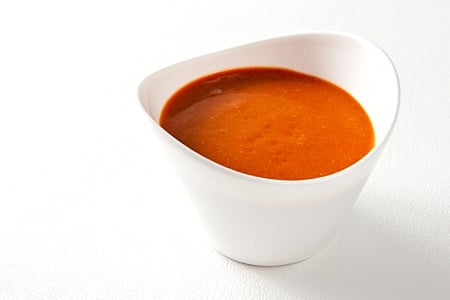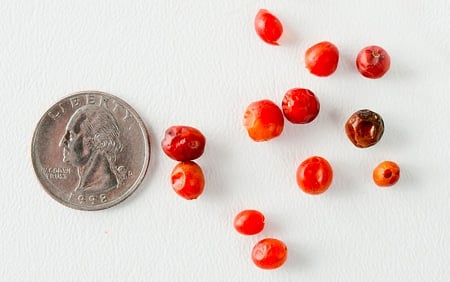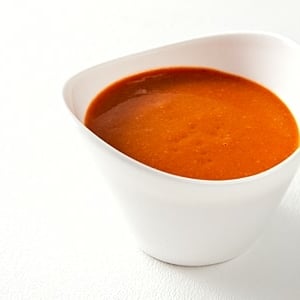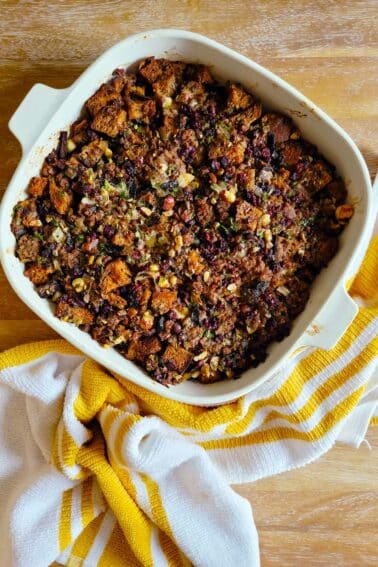As an Amazon Associate I earn from qualifying purchases.

I’ve always wondered about who makes money on all those hot sauce bottles arrayed in the condiment aisle of the supermarket. Especially when it’s easy to make homemade hot sauce.
Think about it: My local Raley’s carries several dozen varieties of hot sauce, and there are thousands of brands of hot sauce out there, ranging from the venerable Tabasco (one of the only hot sauces I still buy) to the ridiculous Dave’s Insanity Sauce, which is so hot it really ought to be a controlled substance. It’s simply a case of too much choice, and not enough difference in the sauces to matter.
I think one of the reasons there is so much hot sauce on the market is because it is so easy to make at home.
(If you’re looking for more of a challenge, I have a recipe for a fermented Tabasco-style hot sauce, too.)
I am imagining all these inspired home cooks in Texas or Florida or New Jersey who were happy making their own sauce, when someone said: “You oughta bottle that!” They do, hemorrhage money, then promptly go out of business a year or so later. Mercifully, I’ve never been tempted to sell my own hot sauce. But if I did, it’d be this one.

And since I am about to give you my recipe, I guess I won’t be making my fortune (or bankrupting myself) on “Hank’s Cray-zey Hawt Sauce” anytime soon. What makes my rendition of homemade sauce so special is the chile — I use wild chiles for this recipe.
Now before I go on, know that any chiles you want to use will work, fresh or dried. But my advice is to make your homemade hot sauce with a single type of chile at first, so you can really enjoy the nuances in that variety, whether it’s serranos, habaneros, poblanos, or any other type, even wild.
Yep. Wild chiles. They exist. Known mostly as chiltepin, pequin or bird’s eye chiles because, I suppose, they are small and round like a bird’s eye, these grow wild in much of Central America — and have the distinction of being the only chile peppers native to the United States. You can forage for them in southern Arizona, New Mexico and Texas, and they reportedly live in southern Florida as well.
I’ve known about chiltepins for years — I am a serious chile head — and I now finally grow them at home, so I have a stash now. You can buy them in Tucson, or in some Mexican markets, too. I’ve found fresh chile pequins in Mexican markets in Brownsville, Texas, for example. You can also buy chiltepin chiles through Gourmet Sleuth. Apparently when the harvest is on, locals drop what they’re doing to gather the little chiles because they bring such a high price — up to $30 a pound in some years.
You can also buy seeds online and grow your own, although the seeds are really hard to germinate; soaking them in chamomile tea for 2 days first will give you a better germination rate.
As for flavor, it’s smoky, hot and rich all at once. The closest store-bought equivalent I can come up with in flavor is Cholula hot sauce, which is another of my favorites. The chiltepin chiles whack you right up front, but then go away — it’s the opposite of a red jalapeno, whose heat can sneak up on you a few minutes later.
I use this hot sauce on pretty much everything: Eggs, Mexican food, cold chicken or pheasant, in tomato sauces, on clams… you get the point. Use it wherever you would use any normal hot sauce.
Homemade Hot Sauce
Ingredients
- 6 garlic cloves, chopped
- 1/2 cup chiltepin chiles, or 2/3 cup Thai chiles
- 1 teaspoon smoked salt
- 1/2 cup water
- 1 cup cider vinegar
- 2 tablespoons sweet paprika
- 1/4 teaspoon xanthan gum mixed with 2 tablespoons cold water
Instructions
- Put everything except the xanthan gum (if using) into a blender and puree for 1-2 minutes. You really want everything blitzed here, so if your blender heats up too much in 2 minutes, stop, let it cool, and continue.
- Pour the xanthan gum that's been mixed with the water into the blender, cover and buzz for another 30 seconds.
- Pour into a bowl or large jar and let this settle for 1 hour to allow all the trapped air you introduced into the sauce while blending to escape. If you skip this step your sauce will not hold together as well. Bottle and store in the fridge for up to 9 months.
Notes
Nutrition information is automatically calculated, so should only be used as an approximation.





Just made this with an assortment of Thai bird chilies, jalapenos and Hungarian wax peppers. I’ve been a hot sauce fan my whole life but can’t imagine ever paying for another bottle after this. I’m off to the market to round up as many different chilies as I can find to play around and make as many different kinds as I can. Thanks for the recipe and tips!!
Mike: Good tip on the roasted fresh chiles. I like that. And I don’t always use xanthan gum, but it really does help the sauce stay together. Skipping it is fine, though.
Spiritrunner: Any small, hot chile will do. A Thai chile is a pretty good substitute, as is a pequin. Look in Mexican markets for dried ones. Cayenne will work, tabasco will work, as will a datil.
All Birds and especially the Doves eat the heck out of them.
I assume that is why they are called Bird Peppers .
I was somewhat surprised to learn that they can be easily grown from seed. Like Ricardo, I thought they had to pass through a birds intestinal track to make germination possible.
Learn something new everyday I guess.
I love a crushed pepper or two in a bowl of Pinto Beans.
is there another chili that might be close second to these?i live in a small town in central cali and they don’t sell those here and the closest city is 50 miles away with no car so not an option.
Jeff, do the doves eat them? That’d be one spicy dove!
I have made hot sauces for 7 or 8 years. I abhor Franks and just barely tolerate Tabasco.
There is lots of good sauces out there. With a PH meter you can tone down the Vinegar to a acceptable level . I have found that Roasted Fermented red peppers Taste the best. Green peppers taste better to me Roasted and not fermented. Try using some fresh roasted red peppers with your dried chilies and I think you may like the flavor even more.
One of the top 2 or 3 I make has anchovies in it typically I don’t use starch but I am experimenting with arrow root. Xanthian gum just looks wrong on a hot sauce label
I’ve never had to do anything super special to get the to germinate well.
I place seeds in a moist paper towel inside a plastic baggy at a temperature of 85 degrees.
Thank you, Hank! I’m glad, as the only chiles I can find up here, aside from the ubiquitous jalapeno, are in their dried form. I’ll be trying my hand at hotsauce now! 🙂
In South Texas , they are always found where doves tend to congregate and roost.
Barbed wire fences are prime spots and easy to follow looking for them.
Warner: Colon cleanser? Yikes. I’ll pass on that one…
Digging Dog: Any special germination tricks? I’ve seen that pepper, which is similar to the chiltepin. I think its a pequin.
Kristin: Go back next week – they ought to still be there, right?
Cindi: Yes, the chiltepins I used were dried, so you’ll be good to go.
Rachel: Yeah, I suppose you can can it. It has enough vinegar in it to seal the jars with a water bath, but I would not go more than 10 minutes – you don’t want to cook the stuff.
Ricardo: Comments like that make my day! Lacking a canary, I will blanch the seeds next time. 😉
Ricardo, what a great description of your part of the world and how you handle pequines!
Other peppers: out in the Galapagos Islands, (which I visited 8 times but only once on pleasure), the local pepper is a perennial bush about two or three feet tall. The peppers themselves are tiny, but pack a wallop you’ll never forget. Took some back to Quito where we were living but could not get the seeds to germinate either. Some form of stratifying like passing seeds through canaries must be the answer. I remember in a plant phsyiology course I took we submerged black locust seeds in sulfuric acid to get them to germinate
My family is from outside of Monterrey, México. We make dry beef or machacado and sell it in several stores of our own, along with local typical candies, breads and preserves, among which is this chile. We call it piquín. Sell it in vinegar whole, or in sauce form, very similar to the one you make, except for the paprika and smoked salt.
They usually start flowering after the rains and many people make a living of foraging them in the woods and orange orchards and sell them at the side of the road. Sometimes you can see little pick up trucks with the tailgate lowered and inside a little 2 feet tall hill of these chiles. Depending of the season, can be quite expensive.
There is also another variation, which I think is also chiltepin, but the fruits are elongated instead of espherical, and it is called japanese chile (go figure), and although it sells well, is less apreciated.
About germination, you need to get rid of the chemical dormancy on the seeds, either by blancheling them a few seconds in boiling water, or feeding the whole chiles to your canary and collecting the seeds later when you change the newspaper from the bottom of the cage. that´s the way most chile plants appear all of themselves sooner or later in our gardens under the trees. They like shadow, and if you take care of them and it doesn´t freeze, they can live for several years. When we go hunting some times find a lot of plants near the water ponds and along fences and get loaded for all the year´s worth. Can put it to dry, make a sauce like yours, put them in vinegar, freeze them, or just put them in a jar mixed with a lot of salt and they will stay moist and edible a long time.
Greetings
Have you tried canning this? I’ve got a ton of peppers coming of age right now but we easily have a gallon of Tapatio.
Can dried chiles be used for this and, if so, would the amount change or preparation be needed?
I saw these sold in Central Market in Austin Tx just yesterday as pequin peppers. They were in small packages the size of an orange. Now I wish I’d bought some.
I agree there are so many hot sauces out there and most of them have a funny or different label which makes them more easy to sell.
I’ve wanted to make my own hot sauce because I love Siracha but want something with the heat but not the garlic. I’ll try this with thai chiles…thanks!
I always learn so much from reading your blog! Had no idea hot sauce was so easy to make!
I love chiltepins.
I grow a chiltepin called McMahon’s Texas Bird Pepper….short easily managed plants with well flavored fruits.
Seeds are available from Seed Saver’s Exchange…..
https://www.seedsavers.org/Details.aspx?itemNo=1478%28OG%29
They get collected. I use Frank’s but I’ve a bottle labeled Pain and Suffering with a picture of a Dominatrix, and one picked up in an Indian spice shop on Manhattan, labeled Colon Cleanser.
Something to bring home to give people something to talk about.